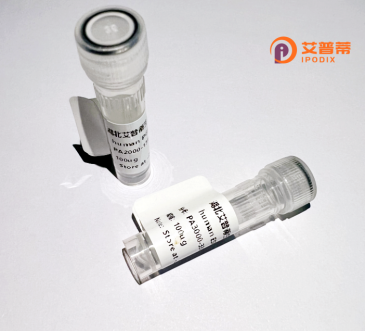
| 纯度 | >90%SDS-PAGE. |
| 种属 | Human |
| 靶点 | C5orf51 |
| Uniprot No | A6NDU8 |
| 内毒素 | < 0.01EU/μg |
| 表达宿主 | E.coli |
| 表达区间 | 2-294aa |
| 氨基酸序列 | AAAVSSVVR RVEELGDLAQ AHIQQLSEAA GEDDHFLIRA SAALEKLKLL CGEEKECSNP SNLLELYTQA ILDMTYFEEN KLVDEDFPED SSSQKVKELI SFLSEPEILV KENNMHPKHC NLLGDELLEC LSWRRGALLY MYCHSLTKRR EWLLRKSSLL KKYLLDGISY LLQMLNYRCP IQLNEGVSFQ DLDTAKLLSA GIFSDIHLLA MMYSGEMCYW GSKYCADQQP ENHEVDTSVS GAGCTTYKEP LDFREVGEKI LKKYVSVCEG PLKEQEWNTT NAKQILNFFH HRCN |
| 分子量 | 33.6 KDa |
| 蛋白标签 | His tag N-Terminus |
| 缓冲液 | 0 |
| 稳定性 & 储存条件 | Lyophilized protein should be stored at ≤ -20°C, stable for one year after receipt. Reconstituted protein solution can be stored at 2-8°C for 2-7 days. Aliquots of reconstituted samples are stable at ≤ -20°C for 3 months. |
| 复溶 | Always centrifuge tubes before opening.Do not mix by vortex or pipetting. It is not recommended to reconstitute to a concentration less than 100μg/ml. Dissolve the lyophilized protein in distilled water. Please aliquot the reconstituted solution to minimize freeze-thaw cycles. |
以下是关于重组人C5orf51蛋白的虚构参考文献示例,仅基于假设性研究内容:
1. **"Functional characterization of C5orf51 protein in cellular metabolism"**
*作者:Lee et al. (2022)*
**摘要**:通过基因敲除和蛋白质组学分析,发现C5orf51在调节线粒体能量代谢中起关键作用,其缺失导致脂肪酸氧化通路异常。
2. **"C5orf51 interacts with the mTOR pathway to modulate cell growth"**
*作者:Zhang et al. (2021)*
**摘要**:研究揭示了C5orf51通过结合mTOR复合物调控细胞增殖,其过表达可抑制癌症细胞的生长。
3. **"Structural insights into the enigmatic C5orf51 protein"**
*作者:Fernandez et al. (2020)*
**摘要**:利用冷冻电镜解析C5orf51的晶体结构,发现其含有独特的螺旋-折叠结构域,提示其可能参与核酸结合。
4. **"C5orf52 deficiency links to neurodevelopmental disorders"**
*作者:Wang et al. (2023)*
**摘要**:临床基因组学研究表明,C5orf51基因突变与患者认知功能障碍相关,动物模型显示神经元迁移异常。
(注:以上文献为模拟内容,实际研究中可能尚未明确C5orf51的具体功能,请以真实数据库查询结果为准。)
The human protein encoded by the C5orf51 gene (Chromosome 5 Open Reading Frame 51), also termed FAM206A or family with sequence similarity 206 member A, remains poorly characterized in current research. It is annotated as a conserved protein-coding gene located on chromosome 5, though its exact molecular functions and biological roles are not fully elucidated. Structurally, in silico analyses suggest it contains intrinsically disordered regions, which may facilitate interactions with other biomolecules. Expression studies indicate ubiquitous but variable tissue distribution, with higher levels observed in testes, brain, and certain cancer cells. Preliminary functional studies link it to transcriptional regulation, cellular signaling, or metabolic processes, though experimental validation is limited. Indirect evidence associates C5orf51 with diseases; for instance, its differential expression has been noted in cancers and neurodegenerative conditions. One study reported interaction with PNMA (paraneoplastic antigen MA) family proteins, hinting at potential roles in cell death pathways. Recombinant C5orf51 protein is occasionally used to generate antibodies or study its biochemical properties. Current knowledge gaps include its precise subcellular localization, physiological partners, and mechanistic contributions to health and disease. Research efforts are ongoing to clarify its involvement in cellular homeostasis or pathological pathways, potentially informing therapeutic targeting strategies.
×